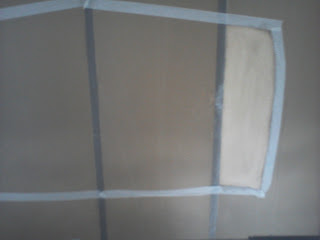Finished wall. The top (where the paint buckets are) is removable to
access the plug sockets. This top section is supported by 2 batons
secured to the wall
This wall was sanded and filled, sanded again and had 2 coats of white emulsion
The
wall was built first so the one projection could be lined up with the
corner of it. this way the box could be placed in a suitable spot to
project and i could then go on to work out the angle needed for the
other projector.
The
projection box at this stage was simply a box. i had yet to angle the
projectors to their required places, the box needed shelves to house the
equipment an dthe box in it entirety needed a proper placement and
pinting.
Once
id worked out where the projections needed to be i then worked out how
to get them to fit inside the projection box and keep the same angle
The
box was pushed towards the back and the one proctor needed to be on top
of the box to angle upwards onto the ceiling. the second projector had
to be close the ground and angled down slightly. So i needed a definite
shelf for this
I had to work this out first so i could make sure
the box would be in the best vantage point to project both films out of
the same box
This
is the ceiling projection on a white wall. demonstrating how the angle
of the footage doesn't look right being on a flat wall, hence the need
of the sloping ceiling in the space.
Once
the angle had been worked out for the top projector, an angled shelf
was built so the projection could be anled at the ceiling. a door was
added with a lock and holes to keep the internal projector cool
Side view. Shows the hole in the top for the cables from the projector to go through to the plus and corresponding dvd player
The second hole in the bottom is for the 2nd projector
Inside view showing the shelves and where the equipment will be placed.
The
dvd player and projector shown are linked together. The top shelf will
be for the dvd player that will be connected to the projector on top of
the box
A view of the finished box once it had been painted




















